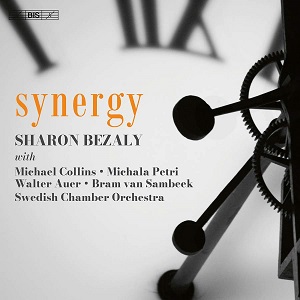
Sharon Bezaly (flute)
Synergy
rec. 2017-22, Orebro konserthus, Sweden; Djursholms kapell, Sweden
BIS BIS2339 SACD [68]
The pre-twenty-first century Western Art Music repertory is essentially static, and gems from that corpus have already been recorded multiple times. Within that environment, those planning to produce yet more recordings of this same music must exercise ever-increasing levels of marketing creativity, and execution skills to ensure success of their undertaking. This recording is a case in point of such an initiative.
The principal musician in this recording is the renowned flautist Sharon Bezaly, accompanied by the Swedish Chamber Orchestra She is joined in four of the five different programme items by an individual musician from a stellar group of four soloists. Three different conductors share the baton for different programme items.
All the music here is thematically associated by the term ‘synergy’. The liner notes go to some lengths to define the term, and then describe how each programme item conforms. For those less familiar with the term, synergy is described as ‘an interaction and cooperation giving rise to a whole that is greater than the simple sum of its parts,’ i.e. 1+1=3. Applied musically it can have an exciting component of unpredictability. Further supporting the theme of synergy, Sharon Bezaly gathered her friends for this recording. As she expresses it: ‘In a successful partnership, one plus one is much greater than two. The musical result grows exponentially’. She also feels it significant that in English, German and French the term ‘playing’ is used with respect to musical instruments. It takes little empathy to perceive the playful pleasure manifested by these musicians meeting and playing together, certainly even further enhanced by the hiatus consequential to Covid restrictions.
The programme items will be familiar to most listeners, probably with one exception: J.S.Bach’s Orchestral Suite. Gems from the Western Art Music repertory have long attracted composers who have been inspired to take the essential elements of the music and then add their own creativity and moniker. There are countless examples of ‘Variations on a Theme’. More recently Max Richter extensively re-worked/rewrote Vivaldi’s ‘Four Seasons’. His degree of success is a matter of opinion. Guitarist Julian Bream took the best elements of two rather ordinary Antonio Diabelli Sonatas, and created a delightful new entity: Sonata in A.
The Bach Orchestral Suite here is more aligned with the initiative of Bream. Gustav Mahler, a great admirer of J.S. Bach, wanted to introduce his work to New York audiences. He made an arrangement, or rather a reassembly of Bach’s Orchestral Suites 2 and 3 by combining the most popular movements from each Suite into a new entity. Advocates of HIP may have apoplexy when hearing Mahler’s reassembly, but it reflects how Bach was appreciated more than a century ago. It is highlighted that the orchestra, in this format, also becomes a soloist, unlike the original.
Seemingly static, undiscovered and unpublished gems from this repertory occasionally emerge. While the Doppler Concerto for two flutes and orchestra was written in 1854, it had to wait for more than a century to be rediscovered and reconstructed by András Adorján. The concerto was conceived by Franz Doppler for his own use, together with his brother Karl. Knowing the musical skills of his sibling, the composer placed significant demands on both musicians. There are many passages within the music where the two soloists must play in perfect synchronization as though one. To execute this they must have perfect control of the dynamic palette, exceptionally precise articulation and consummate technical command. Oddly, in the superior performance of these passages, 1+1=1.
This is a well-conceived, and tastefully chosen programme that most will find entertaining and musically fulfilling. As one would anticipate, performances are of the highest standard and the purported synergy is evident in all aspects of the programme. The Bach Orchestral Suite creates an element of ‘aural uneasiness’ on initial hearing, but it is an interesting insight into the genius of two composers.
The recording evidences that creative programming, and presentation can give heightened appeal, insight and enjoyment of familiar music from the past. The sonic recording qualities of this BIS SACD are exemplary, an attribute that further enhances overall enjoyment of this music.
Zane Turner
Help us financially by purchasing from



Contents
Georg Philipp Telemann (1681-1767)
Concerto in E minor TWV 52:e1
Sharon Bezaly (flute)
Michala Petrie (recorder)
Swedish Chamber Orchestra/Urban Svensson
Camille Saint-Saëns (1835-1921)
Tarentelle Op 6
Sharon Bezaly (flute)
Michael Collins (clarinet)
Swedish Chamber Orchestra/Michael Collins
Franz Doppler (1821-83)
Concerto in D minor
Sharon Bezaly (flute)
Walter Auer (flute)
Swedish Chamber Orchestra/ Thomas Dausgaard
Heitor Villa-Lobos (1887-1959)
Bachianas Brasileiras No 6
Sharon Bezaly (flute)
Bram van Sambeek (bassoon)
Johann Sebastian Bach (1685-1750) arr. Gustav Mahler
Suite aus den Orchesterwerken (1909) – Badinerie
Sharon Bezaly (flute)
Swedish Chamber Orchestra/Michael Collins


















